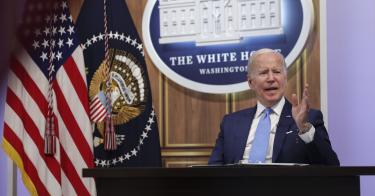It goes without saying that bailing out bad actors is not equitable. So, it’s no wonder the Biden administration left any mention of a nearly $100 billion selective bailout of private union pension plans out of its “Advancing Equity Through the American Rescue Plan” report.
To date, 37 multiemployer pension plans have requested between $4 million and $35 billion each, with 25 of those plans already approved to receive $6.5 billion of an estimated $97 billion in taxpayer money.
These never-before in U.S. history, no-strings-attached taxpayer bailouts of private multiemployer or union pension plans are part of the American Rescue Plan—despite the fact that this decadeslong problem has nothing to do with COVID-19.
Prior to the pandemic, multiemployer plans had accumulated $757 billion in unfunded pension promises, and were on track to collectively pay out only 42 cents on the dollar in promised benefits.
Now, they’re on track to pay out even less, with taxpayers guaranteeing that 100% of whatever certain union pension plans promise will be delivered—at least through 2051.
Multiemployer pensions are plans run by unions and employer representatives, pooling workers together across an industry, such as construction or mining.
Although the numbers are declining, 10.8 million workers and retirees belong to about 1,400 multiemployer plans across the U.S.
Historically, these plans have overpromised and underfunded by making assumptions—such as higher-than-realized rates of return on investments and lower-than-experienced life expectancies—that resulted in far too little money being set aside to pay future benefits.
As it became clear plans were growing increasingly underfunded, they consistently failed to correct their assumptions and increase contributions.
The equitable solution to unfunded multiemployer pension plans would have been to impose accountability on the people running those plans and to fix the system so that that never happens again.
Without that, actions that should be illegal—unions and employers selling workers a bill of goods—will not only continue to go unchecked, but will be encouraged.
The American Rescue Plan’s pension bailout didn’t include a single change to improve union pension plans’ funding, it fails to hold bad actors accountable, and it imposes zero consequences on plans that receive bailouts.
The bailout works like this: Plans that are in the worst financial shape can apply to receive lump-sum cash transfers direct from the Treasury (euphemistically called “special financial assistance”) in an amount sufficient to continue paying 100% of promised pension benefits through 2051.
Plans that had already become insolvent and were paying reduced benefits can receive enough funds to cover 100% of the next 30 years of benefits plus lump-sum payments to retroactively reverse past benefit cuts.
Instead of imposing accountability on irresponsible and sometimes reckless plan managers, the bailout uses taxpayer dollars to pay their compensation for the next 30 years.
The Congressional Budget Office initially estimated that 185 plans—about 13% of all union pension plans—would receive taxpayer funds, at a cost of $86 billion. But since multiemployer pension plans can use whatever discount-rate assumptions they deem “reasonable”—a fatal flaw in the system—plans can reduce their assumed rate of return, and thus their funding status, to become eligible for bailouts.
Not surprisingly, more unfunded plans have taken the bait than originally projected, and the Pension Benefit Guaranty Corp. now expects 268 plans to receive bailouts at a cost of $97 billion.
This bailout only covers the tip of the $757 billion-and-rising union pension iceberg as 96% of all workers with multiemployer pensions are in plans that are less than 60% funded, and 78% have plans that are less than 50% funded.
It’s only a matter of time before virtually all union pension plans fail, and this bailout only modestly kicks the can down the road. The majority of union pension plans that won’t qualify for bailouts are on the path to insolvency. And, as the CBO noted, the overwhelming majority of plans that do receive bailouts will still become insolvent after 2051 when the taxpayer funds run out.
So, what would have been an equitable solution? Fixing the rules so that this never happens again, imposing accountability on unions and employers managing pension plans, and minimizing pension losses across workers and retirees.
I’ve advocated for 12 reforms that would achieve those goals and create a better pension system for current and future workers and retirees.
In general, those reforms would make multiemployer pension plans subject to the same standards as single-employer pension plans that are well-funded and well-insured. They would prevent dangerously underfunded union plans from continuing to make new promises until they can make good on their existing ones, and they would establish a better pension insurance system to prevent pension losses.
Within the existing bailouts, Congress should stipulate that any plan receiving taxpayer dollars should not be allowed to increase any pension benefits, nor to reduce pension contributions, and should have to move toward the same set of funding rules required of single-employer pension plans.
Picking winners and losers among near-universally underfunded union pension plans, incentivizing instead of prohibiting what should be criminal behavior on the part of unions and employers, and requiring hardworking taxpayers to pick up the tab are not equitable.
This piece originally appeared in The Daily Signal




